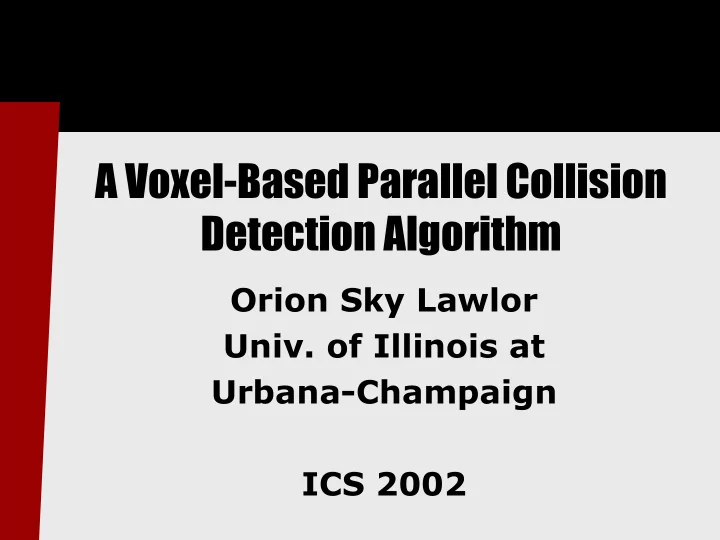

A Voxel-Based Parallel Collision Detection Algorithm Orion Sky Lawlor Univ. of Illinois at Urbana-Champaign ICS 2002
Introduction Simulated objects can occupy the same space at the same time. Physical objects can’t.
Collision Detection ( Contact ) � Given a set of objects, which objects overlap? � Equivalently, which pairs of objects overlap? � Variations (not covered here): � When’s the next overlap? � How much do the objects overlap? � Which objects should be moved? � How much should they be moved?
A well-known, widely quoted, and totally irrelevant result � For two convex polyhedra of n vertices, can determine overlap in O( lg n ) time
Much more useful result � Given n independent objects, it takes Ω (n) time to determine if any collisions exist � Proof via adversary argument: � If you look at less than n objects, I can change one you didn’t look at to make a collision � Does not apply if you’ve seen the objects before–collision scheduling (bounded velocities)
Naive Collision Detection � Test every pair of objects for intersection � Algorithm is always O(n^2) � Common useless optimization: first test object bounding boxes � Advantages: � Easy to write � Trivial to parallelize, if you ignore data replication
Voxel Algorithm: Motivation � We don’t intersect if: � None of me touches none of you � None of my bounding box touches none of yours � I’m completely inside any box you’re completely outside � Idea: Avoid all-pairs problem by finding a nice set of boxes
Voxel Algorithm: Idea � Overlay regular grid (of voxels) over problem domain � Add objects to each voxel they touch � Collide objects in each voxel � Advantages: � Immediately divide up far-away objects � Naturally parallel, even with data movement
Voxel Algorithm: Picture
Voxel Algorithm: Implementation � Voxels form a sparse 3D array � Voxels accept objects they touch from across the machine � Voxels do serial collision detection work, so should be load balanced � A voxel should be near its objects, for efficiency � Perfect match for Charm++ Parallel Object Array framework
Charm++ Parallel Object Arrays � Dynamic parallel objects scattered across the machine � “Indexable” via sparse 3D index � Migratable for automatic load balance � Collective operations: � Broadcast (start colliding) � Reduction (collect collisions) � Intelligent creation (createhere)
Charm++ Arrays: Smart Creation � New voxels created whenever objects are created or moved � Default semantics: create new voxel on the same processor as its object � Charm++ needs communication to resolve creation race � Result: after creation, local voxels are communication-free
Serial Scaling
Parallel Scaled Problem
Conclusions � Voxel algorithm [Turk 1989] an efficient collision detection method � Serial version quite fast � Easy to describe and implement � Naturally parallel � Charm++ good foundation for sparse, dynamic parallel apps � Collaborating on real application
Future Work � Rather silly to use regular grid � Easy to compute, but poor match to objects � Might use multiresolution grids � Large objects in large cells � Small objects in small cells � Must handle overlapping cells
Floating-Point Hack � Float to int conversion is slow � Can replace with “normalization add” followed by a cast � [Chris Hecker 1996], others…
Floating-Point Hack in Decimal � Start with number like 12.3 (Stored as 1,230,000 x10 -5 ) � � Add 1,000,000.0 � Get 1,000,012.3 (Stored as 1,000,012 x10 0 ) � � Note: � Integer part shifted to right � Rounding truncates result
Floating-Point Hack Performance
O ( 1 ) Collisions � Sometimes we try to maintain a constant number of collisions � Still have to look at all the objects
O ( n 2 ) Collisions � It’s possible for every object to intersect every other object � Pretty unlikely, though!
O ( n ) Collisions � Physical simulations often have linear number of collisions (bounded number per object)
Recommend
More recommend